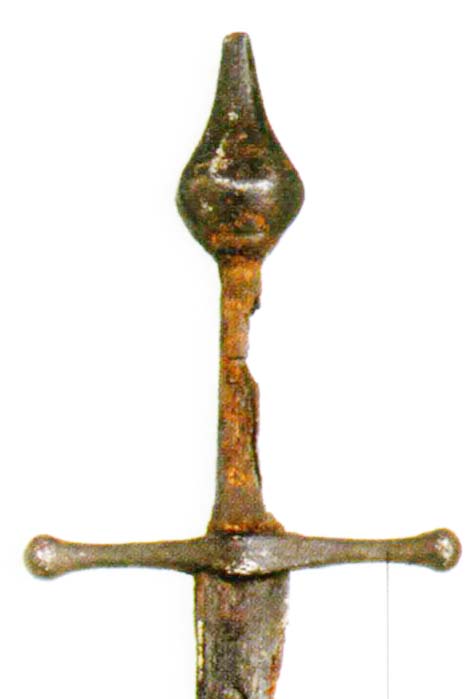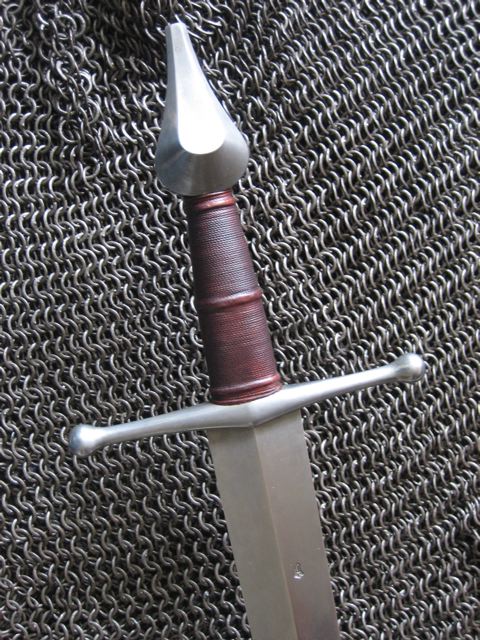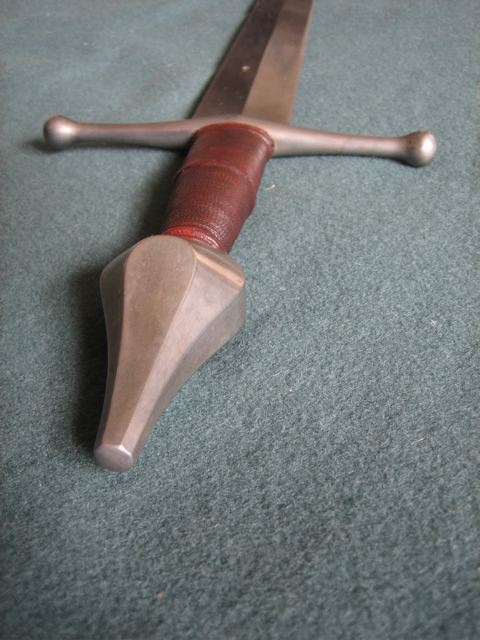| Author |
Message |
Randall Moffett

|
 Posted: Fri 25 Aug, 2006 8:26 am Post subject: Posted: Fri 25 Aug, 2006 8:26 am Post subject: |
 |
|
Nathan,
Thanks for putting that up. I can send you some pics of one of the castillon swords at the museum I am working at. I can go and take pics or close ups if desired on Monday as well.
RPM
|
|
  |
 |
|
Russ Ellis
Industry Professional
|
 Posted: Fri 25 Aug, 2006 12:12 pm Post subject: Re: Talbot's sword Posted: Fri 25 Aug, 2006 12:12 pm Post subject: Re: Talbot's sword |
 |
|
| Craig Johnson wrote: | Hey Russ
I think, if I remeber correctly, that Ewart says one sword above the rest in the find was exceptionally fine and one could imagine that Talbot himself could have welded it as a warrior of such stature would almost certainly have a sword as fine as money could buy. It may have been illustartive of the quality of the swords feel than the actuall attribution to the lord as the owner of the sword. This is off the top of my memory so I will try and check and make sure that it is what I stated above. :-)
Craig |
You might be right, but I was thinking there was more to it then that. The sword in question had the Earl's coat of arms or family badge on it or something... drat... I've really got to look this up...
TRITONWORKS Custom Scabbards
|
|
  |
 |
Roger Hooper

|
 Posted: Fri 25 Aug, 2006 2:38 pm Post subject: Posted: Fri 25 Aug, 2006 2:38 pm Post subject: |
 |
|
Here is a quote from Records of the Medieval Sword: page 11
Oakeshott writes, “That part of the Dordogne was the principal supply-route from the great English base at Bordeaux to the up-river castles which in the 1420s and 1440s were still precariously held by the English during the closing years of the Hundred Years’ War. They were evidently (or at least presumably) in a barge, which in some way was sunk, going up to Bergerac or Castillon with supplies.
“These were all fine-quality swords, but they were not new when they reached the mud of the river. All the good ones (most of which I have seen and handled) show unmistakeable signs of wear – considerable wear, nicks in the edges and the irregularities caused by honing. The only assumption one can make upon the evidence so far examined is that they were used blades re-hilted by a contractor, maybe in England or perhaps in the Burgundian low countries.”
If Oakeshott is accurate here, I don't see how one of these swords could have been Talbot's personal weapon.
|
|
  |
 |
Chad Arnow
myArmoury Team


|
 Posted: Tue 30 Jun, 2009 7:20 am Post subject: Posted: Tue 30 Jun, 2009 7:20 am Post subject: |
 |
|
Here's another sword from the Dordogne. It has the same guard as many of the swords and the same pommel as one of them. Check out the blade. It may just be corrosion/bending of the blade, but it looks single-edged and slightly curved at the end. It looks like it has a fuller along what would be the back edge.
I think it's a falchion, which would be unique among these swords.
 Attachment: 17.45 KB Attachment: 17.45 KB


ChadA
http://chadarnow.com/
|
|
    |
 |
Christopher Gregg

|
 Posted: Tue 30 Jun, 2009 7:54 am Post subject: Posted: Tue 30 Jun, 2009 7:54 am Post subject: |
 |
|
I agree, Chad. I'd go so far as to call it a 'Storta". Definitely a falchion-type sword, fullered back, curved tip. I'd like to see someone replicate this! 
Christopher Gregg
'S Rioghal Mo Dhream!
|
|
  |
 |
Jean Thibodeau

|
 Posted: Tue 30 Jun, 2009 8:54 am Post subject: Posted: Tue 30 Jun, 2009 8:54 am Post subject: |
 |
|
| Chad Arnow wrote: | Here's another sword from the Dordogne. It has the same guard as many of the swords and the same pommel as one of them. Check out the blade. It may just be corrosion/bending of the blade, but it looks single-edged and slightly curved at the end. It looks like it has a fuller along what would be the back edge.
I think it's a falchion, which would be unique among these swords. |
I assume you have noticed that the pommel is very much the same as the one on the Albion Doge and the Venetian swords on which it is based.
These types of pommels may have been more common than I assumed ? ( An Italian or French style ??? Or, popular in most of Europe ? ).
From my experience with the Doge these pommels are very comfortable and can give good support to the heel of the hand if one slips one's grip in a cut to the rear of the grip for that little extra snap.
I wonder if a falchion with a hilt like the Doge would be a historically credible design ? Might be interesting as a custom project. 
You can easily give up your freedom. You have to fight hard to get it back!
|
|
  |
 |
Chad Arnow
myArmoury Team


|
 Posted: Tue 30 Jun, 2009 9:28 am Post subject: Posted: Tue 30 Jun, 2009 9:28 am Post subject: |
 |
|
| Jean Thibodeau wrote: |
I assume you have noticed that the pommel is very much the same as the one on the Albion Doge and the Venetian swords on which it is based.
|
In silhouette, they are very similar, but not in profile, I don't believe. The ones on the Dordogne swords are pretty standard round scent-stoppers, just mounted upside down. Think the pommel of the Mercenary or of the Earl put on upside down. The Doge has a tear drop shop, true, but is different with its angles and flat spots.
Swords like the Doge also seem to date from later in the 15th century than these swords.

ChadA
http://chadarnow.com/
|
|
    |
 |
Chad Arnow
myArmoury Team


|
 Posted: Tue 30 Jun, 2009 10:18 am Post subject: Posted: Tue 30 Jun, 2009 10:18 am Post subject: |
 |
|
Here's a closeup of that hilt.
Check out Nathan's pics of the group above. The right-most swords are noted by Oakeshott to have pommels "of the same form" except that one of them is mounted upside-down. In later works, he called the upside-down pear group Group C, where in Nathan's pic (from Oakeshott's first article on the subject), he lumps it in with Group B.
Oakeshott calls pommels of these Group C Castillon swords "pear-shaped mounted upside down." Of course, he doesn't mention anything single-edged and says that of the three Group C swords, two are of Type XX and one is just a hilt and portion of damaged blade.
Oakeshott mentions that a sword with an upside-down pear pommel appears in Spanish art c. 1425. Those Venetian swords are later, though there are similarities.
 Attachment: 24.93 KB Attachment: 24.93 KB


ChadA
http://chadarnow.com/
|
|
    |
 |
|
Peter Johnsson
Industry Professional
|
 Posted: Tue 30 Jun, 2009 10:43 am Post subject: Posted: Tue 30 Jun, 2009 10:43 am Post subject: |
 |
|
This falchion from the Castillion find is more or less unpublished. I did not know there were images available of it on the internet.
It shares the exact same pommel type with two other swords from the same find. One of these is also in Leeds and the other is on display in Paris Army Museum. Both these other two swords are extremely similar. They are double edged, have a tripple fullered ricasso and the same guard as the falchion, with clubbed ends.
I have documented both the falchion and its double edged cousin in Leeds a couple of years ago. At that time, Robert Woosnam-Savage told me he planned to write an article about these specific swords, so I have sort of kept my impressions a bit low profile. They are all truly wonderful swords of very good quality in the making.
The pommel type does share the basic principles with those famous Venetian swords, although the venetian ones are more extreme.
The Castillion ones are not simply upward down equal sided octagonal pear shaped pommels, however. The bevels run around the contour, laving a tear shaped panel front and back of the pommel. Pretty much like the Venetian ones but with more of a swell in the mid face.
The blades on these swords show remains of gold inlay/ gilding. Floral patterns, medallions and inscriptions. It is no longer possible to clearly make out the details of the decoration or meaning of the letters.
I find it strange that Oakeshott could have made the mistake to think the Falchion was a damaged double edged blade. If you only give it a casual glance, the cross section at the base might mislead you, perhaps. The section of the blade is almost hexagonal after the ricasso and onward a bit. The blade is overall pretty much eaten by rust, but enough remains to show original shape. It is rather much like a 15th C development of the Thorpes falchion, although a bit more detailed in fullering, bevels and ricasso.
Theses three swords do feel different in character from the rest of the swords. You have two handers (a few) and some hand and halfs as well as the large group of single hand type XVIII and XV (that are all like made after a single specification or pattern). The ones that share the unusual peaked pommel seems to me to come from some other maker and are absolutely made to a different specification that the rest of the swords.
Last edited by Peter Johnsson on Tue 30 Jun, 2009 10:49 am; edited 1 time in total
|
|
   |
 |
Chad Arnow
myArmoury Team


|
|
    |
 |
Nathan Robinson
myArmoury Admin


|
|
    |
 |
|
Dustin R. Reagan
|
 Posted: Tue 30 Jun, 2009 11:03 am Post subject: Posted: Tue 30 Jun, 2009 11:03 am Post subject: |
 |
|
| Chad Arnow wrote: | Here's a closeup of that hilt.
Check out Nathan's pics of the group above. The right-most swords are noted by Oakeshott to have pommels "of the same form" except that one of them is mounted upside-down. In later works, he called the upside-down pear group Group C, where in Nathan's pic (from Oakeshott's first article on the subject), he lumps it in with Group B.
Oakeshott calls pommels of these Group C Castillon swords "pear-shaped mounted upside down." Of course, he doesn't mention anything single-edged and says that of the three Group C swords, two are of Type XX and one is just a hilt and portion of damaged blade.
Oakeshott mentions that a sword with an upside-down pear pommel appears in Spanish art c. 1425. Those Venetian swords are later, though there are similarities. |
Does anyone have any clues as to how these pommels were mounted? Do they show signs that the tang passes completely through the pommel and is then peened? My Albion Doge doesn't show any signs of this, but it could just be that the peen is blended exceptionally well with the pommel, in this case. I doubt this, though, because each of my other albions have a subtle, but noticeable boundary line between the peen & pommel.
Thanks,
Dustin
|
|
  |
 |
|
Peter Johnsson
Industry Professional
|
 Posted: Tue 30 Jun, 2009 11:39 am Post subject: Posted: Tue 30 Jun, 2009 11:39 am Post subject: |
 |
|
Dustin,
The tang reaches all the way through the pommel and is riveted at the peak of the pommel. This is the impression I have from the originals and that is how I make these pommels and also how they are made at Albion.
It is possible to get an invisible line between rivet head and pommel by working carefully.
The originals does not show a clear line for the rivet head either, but that is nothing strange. At times the peen does not stand very clear or at all.
Below, two photos of a sword I made based on the measurements of the Castillion swords. The blade is of a different type, but the hilt is more or less exactly the same.
 Attachment: 107.37 KB Attachment: 107.37 KB

 Attachment: 54.71 KB Attachment: 54.71 KB

|
|
   |
 |
Nathan Robinson
myArmoury Admin


|
 Posted: Tue 30 Jun, 2009 11:50 am Post subject: Posted: Tue 30 Jun, 2009 11:50 am Post subject: |
 |
|
Peter!
I love that sword. Love it.
When I had a Doge here that I inevitably sent away as a contest prize, I had wondered what it would be like to combine the pommel of its with the cross-guard of the Albion Castellan to try to make an "inspired" version of the same sword from which you modeled your piece.
It wasn't really until I handled the Albion Castellan that I really had much thought about these types of sword with their round cross-guards and "knobby" finals. The Castellan changed my mind and I've been attracted to them ever since.
.:. Visit my Collection Gallery :: View my Reading List :: View my Wish List :: See Pages I Like :: Find me on Facebook .:.
|
|
    |
 |
|
Dustin R. Reagan
|
 Posted: Tue 30 Jun, 2009 12:11 pm Post subject: Posted: Tue 30 Jun, 2009 12:11 pm Post subject: |
 |
|
| Peter Johnsson wrote: |
The tang reaches all the way through the pommel and is riveted at the peak of the pommel. |
Thank you! I believe I understand what you mean, but could you clarify? What part of the pommel are you referring to when you say the 'peak'? Would you mind editing one of the photos you posted (beautiful sword, by the way! i love it!) to point out where the blended rivet head is?
Thanks again,
Dustin
|
|
  |
 |
Roger Hooper

|
 Posted: Tue 30 Jun, 2009 12:22 pm Post subject: Posted: Tue 30 Jun, 2009 12:22 pm Post subject: |
 |
|
Ooohh  I have to echo the above comments and say that is a beautiful sword, Peter. Type 11 guards are my favorites, especially as they appear on the Albion models. I have to echo the above comments and say that is a beautiful sword, Peter. Type 11 guards are my favorites, especially as they appear on the Albion models.
Last edited by Roger Hooper on Tue 30 Jun, 2009 12:38 pm; edited 1 time in total
|
|
  |
 |
Nathan Robinson
myArmoury Admin


|
 Posted: Tue 30 Jun, 2009 12:27 pm Post subject: Posted: Tue 30 Jun, 2009 12:27 pm Post subject: |
 |
|
Dustin-
The tang goes all the way through the pommel is and peened at the very end. It's well blended and so it's not obvious.
Maybe you're confused by the "riveted" phrase. That simply means that the end of the tang is pounded and mushroomed a bit near the end of the opening of the pommel to secure the construction. There is no separate "rivet" or "head", but only the end of the tang as it mates to the pommel. Careful blending in the finishing process creates a near-seamless appearance as can be seen on the example below.
Attached is a photo of the Albion Doge that Bill Grandy photographed.
 Attachment: 64.99 KB Attachment: 64.99 KB

Albion Doge, photograph by Bill Grandy
.:. Visit my Collection Gallery :: View my Reading List :: View my Wish List :: See Pages I Like :: Find me on Facebook .:.
|
|
    |
 |
|
Danny Grigg
|
 Posted: Thu 02 Jul, 2009 2:11 am Post subject: Posted: Thu 02 Jul, 2009 2:11 am Post subject: |
 |
|
Chad
Thanks for posting that Falchion. Someone needs to make a replica of this beauty.
I was going to post a new thread regarding that book to see if it was worth buying or not, but after seeing that one pic of the Falchion I'm going to purchase a copy.
Thanks once again Chad.
Danny
|
|
  |
 |
Roger Hooper

|
|
  |
 |
Matt Easton

Location: Surrey, UK. Joined: 30 Jun 2004
Posts: 241
|
|
    |
 |
|
|

